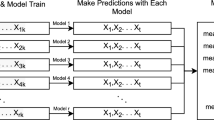Abstract
Kernel density estimation (KDE) is a popular technique used to estimate the probability density function of a random variable. KDE is considered a fundamental data smoothing algorithm, and it is a common building block in many scientific applications. In a previous work we presented S-KDE, an efficient algorithmic approach to compute KDE that outperformed other state-of-the-art implementations, providing accurate results in much reduced execution times. Its parallel implementation targeted multi- and many-core processors. In this work we present an OpenCL implementation of S-KDE, targeting modern accelerators in a portable way. We test our implementation on three accelerators from different manufacturers, achieving speedups around \(5\times \) compared to a hand-tuned serial version of S-KDE. We also analyze the performance of the code in these accelerators, to find out to what extent our code exploits their capabilities.
















Similar content being viewed by others
References
Agosta G, Barenghi A, Di Federico A, Pelosi G (2015) Opencl performance portability for general-purpose computation on graphics processor units: an exploration on cryptographic primitives. Concurr Comput Pract Exp 27(14):3633–3660
AMD (2013) App opencl programming guide. http://developer.amd.com/tools/hc/AMDAPPSDK/assets/AMD_Accelerated_Parallel_Processing_OpenCL_Programming_Guide.pdf
Cramer T, Schmidl D, Klemm M, an Mey D (2012) Openmp programming on intel xeon phi coprocessors: an early performance comparison. In: Proceedings of the many-core applications research community symposium, pp 38–44
Danalis A, Marin G, McCurdy C, Meredith JS, Roth PC, Spafford K, Tipparaju V, Vetter JS (2010) The scalable heterogeneous computing (shoc) benchmark suite. In: Proceedings of the 3rd workshop on general-purpose computation on graphics processing units, ACM, New York, GPGPU ’10, pp 63–74
Elgammal A, Duraiswami R, Davis L (2003) Efficient kernel density estimation using the fast gauss transform with applications to color modeling and tracking. IEEE Trans Pattern Anal Mach Intell 25(11):1499–1504
Fukunaga K (1990) Introduction to statistical pattern recognition, 2nd edn. Academic Press Professional Inc, San Diego
Jeffers J, Reinders J (2013) Intel Xeon Phi Coprocessor High Performance Programming, 1st edn. Morgan Kaufmann Publishers Inc., San Francisco
Jia H, Zhang Y, Long G, Xu J, Yan S, Li Y (2012) Gpuroofline: a model for guiding performance optimizations on gpus. Euro-Par Parallel Processing, Lecture Notes in Computer Science, vol 7484. Springer, Berlin, pp 920–932
Khronos OpenCL Working Group , Munshi A (ed) (2008) The OpenCL specification. Khronos Group, Beaverton, OR
Kim KH, Kim K, Park QH (2011) Performance analysis and optimization of three-dimensional FDTD on GPU using roofline model. Comput Phys Commun 182(6):1201–1207
Kirk DB, WmW Hwu (2010) Programming Massively Parallel Processors: A Hands-on Approach, 1st edn. Morgan Kaufmann Publishers Inc., San Francisco
Lattner C, Adve V (2004) Llvm: a compilation framework for lifelong program analysis transformation. In: Proceedings of the international symposium on code generation and optimization, CGO, pp 75–86
Lee VW, Kim C, Chhugani J, Deisher M, Kim D, Nguyen AD, Satish N, Smelyanskiy M, Chennupaty S, Hammarlund P, Singhal R, Dubey P (2010) Debunking the 100x gpu vs. cpu myth: an evaluation of throughput computing on cpu and gpu. SIGARCH Comput Archit News 38(3):451–460
Lopez-Novoa U, Mendiburu A, Miguel-Alonso J (2015a) A survey of performance modeling and simulation techniques for accelerator-based computing. IEEE Trans Parallel Distrib Syst 26(1):272–281
Lopez-Novoa U, Sáenz J, Mendiburu A, Miguel-Alonso J (2015b) An efficient implementation of kernel density estimation for multi-core and many-core architectures. Int J High Perform Comput Appl 29(3):331–347
Lopez-Novoa U, Sáenz J, Mendiburu A, Miguel-Alonso J, Errasti I, Esnaola G, Ezcurra A, Ibarra-Berastegi G (2015c) Multi-objective environmental model evaluation by means of multidimensional kernel density estimators: Efficient and multi-core implementations. Environ Model Softw 63:123–136
Munshi A, Gaster B, Mattson TG, Fung J, Ginsburg D (2011) OpenCL Programming Guide, 1st edn. Addison-Wesley Professional, USA
Nickolls J, Dally W (2010) The gpu computing era. IEEE Micro 30(2):56–69
NVIDIA (2012) Opencl best practices guide. http://www.nvidia.com/content/cudazone/CUDABrowser/downloads/papers/NVIDIA_OpenCL_BestPracticesGuide.pdf
Pennycook S, Hammond S, Wright S, Herdman J, Miller I, Jarvis S (2013) An investigation of the performance portability of opencl. J Parallel Distrib Comput 73(11):1439–1450
Seo S, Lee J, Jo G, Lee J (2013) Automatic opencl work-group size selection for multicore cpus. In: Proceedings of the 22nd international conference on parallel architectures and compilation techniques (PACT), pp 387–397
Sheather SJ (2004) Density estimation. Statist Sci 588–597
Silverman BW (1986) Density estimation for statistics and data analysis. Chapman & Hall, London
Torres Y, Gonzalez-Escribano A, Llanos DR (2013) ubench: exposing the impact of cuda block geometry in terms of performance. J Supercomput 65(3):1150–1163
Wang Y, Qin Q, SEE SCW, Lin J (2013) Performance portability evaluation for openacc on intel knights corner and nvidia kepler. In: HPC China 2013
Weissbach R (2006) A general kernel functional estimator with general bandwidth-strong consistency and applications. J Nonparam Stat 18(1):1–12
Williams S, Waterman A, Patterson D (2009) Roofline: an insightful visual performance model for multicore architectures. Commun ACM 52(4):65–76
Author information
Authors and Affiliations
Corresponding author
Additional information
This work has been partially supported by the Saiotek and Research Groups 2013-2018 (IT- 609-13) programs (Basque Government), TIN2013-41272P (Ministry of Science and Technology), COMBIOMED-RD07/0067/0003 network in computational biomedicine (Carlos III Health Institute) and by the NICaiA Project PIRSES-GA-2009-247619 (European Commission).
Rights and permissions
About this article
Cite this article
Lopez-Novoa, U., Mendiburu, A. & Miguel-Alonso, J. Kernel density estimation in accelerators. J Supercomput 72, 545–566 (2016). https://doi.org/10.1007/s11227-015-1577-7
Published:
Issue Date:
DOI: https://doi.org/10.1007/s11227-015-1577-7




